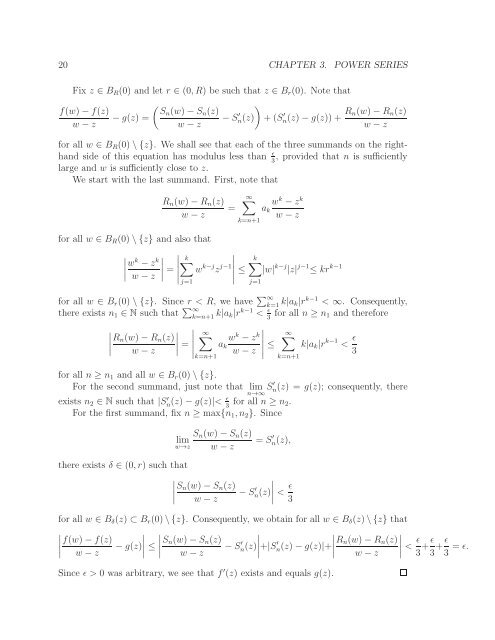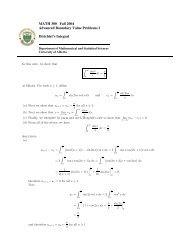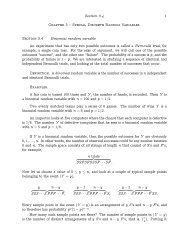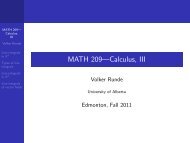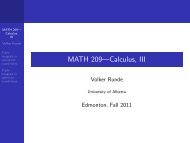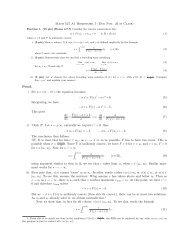Math 411: Honours Complex Variables - University of Alberta
Math 411: Honours Complex Variables - University of Alberta
Math 411: Honours Complex Variables - University of Alberta
Create successful ePaper yourself
Turn your PDF publications into a flip-book with our unique Google optimized e-Paper software.
20 CHAPTER 3. POWER SERIES<br />
Fix z ∈ BR(0) and let r ∈ (0,R) be such that z ∈ Br(0). Note that<br />
�<br />
f(w)−f(z) Sn(w)−Sn(z)<br />
−g(z) = −S<br />
w −z w−z<br />
′ �<br />
n(z) +(S ′ n(z)−g(z))+ Rn(w)−Rn(z)<br />
w−z<br />
for all w ∈ BR(0)\{z}. We shall see that each <strong>of</strong> the three summands on the righthand<br />
side <strong>of</strong> this equation has modulus less than ǫ<br />
, provided that n is sufficiently<br />
3<br />
large and w is sufficiently close to z.<br />
We start with the last summand. First, note that<br />
Rn(w)−Rn(z)<br />
w −z<br />
for all w ∈ BR(0)\{z} and also that<br />
� �<br />
� �<br />
� �<br />
� � =<br />
�<br />
� k� �<br />
�<br />
�<br />
w k −z k<br />
w −z<br />
j=1<br />
=<br />
w k−j z j−1<br />
∞�<br />
k=n+1<br />
�<br />
�<br />
�<br />
�<br />
� ≤<br />
k�<br />
j=1<br />
w<br />
ak<br />
k −zk w −z<br />
|w| k−j |z| j−1 ≤ kr k−1<br />
for all w ∈ Br(0)\{z}. Since r < R, we have �∞ k=1k|ak|r k−1 < ∞. Consequently,<br />
there exists n1 ∈ N such that �∞ k=n+1k|ak|r k−1 < ǫ<br />
3 for all n ≥ n1 and therefore<br />
� �<br />
�<br />
�<br />
Rn(w)−Rn(z) �<br />
�<br />
� w−z � =<br />
�<br />
�<br />
�<br />
�<br />
�<br />
∞�<br />
k=n+1<br />
ak<br />
w k −z k<br />
w −z<br />
�<br />
�<br />
�<br />
�<br />
� ≤<br />
∞�<br />
k=n+1<br />
k|ak|r k−1 < ǫ<br />
3<br />
for all n ≥ n1 and all w ∈ Br(0)\{z}.<br />
For the second summand, just note that lim S<br />
n→∞ ′ n(z) = g(z); consequently, there<br />
exists n2 ∈ N such that |S ′ ǫ<br />
n (z)−g(z)|< for all n ≥ n2.<br />
3<br />
For the first summand, fix n ≥ max{n1,n2}. Since<br />
Sn(w)−Sn(z)<br />
lim<br />
w→z w −z<br />
there exists δ ∈ (0,r) such that<br />
�<br />
�<br />
�<br />
Sn(w)−Sn(z)<br />
� w−z<br />
−S ′ n (z)<br />
= S ′ n (z),<br />
for all w ∈ Bδ(z) ⊂ Br(0)\{z}. Consequently, we obtain for all w ∈ Bδ(z)\{z} that<br />
� �<br />
�<br />
�<br />
f(w)−f(z) �<br />
� −g(z) �<br />
w−z � ≤<br />
�<br />
�<br />
�<br />
Sn(w)−Sn(z)<br />
� −S<br />
w −z<br />
′ n (z)<br />
�<br />
�<br />
�<br />
� +|S′ n (z)−g(z)|+<br />
� �<br />
�<br />
�<br />
Rn(w)−Rn(z) �<br />
�<br />
ǫ<br />
� w−z � <<br />
3 +ǫ<br />
3 +ǫ = ǫ.<br />
3<br />
�<br />
�<br />
�<br />
�<br />
< ǫ<br />
3<br />
Since ǫ > 0 was arbitrary, we see that f ′ (z) exists and equals g(z).


